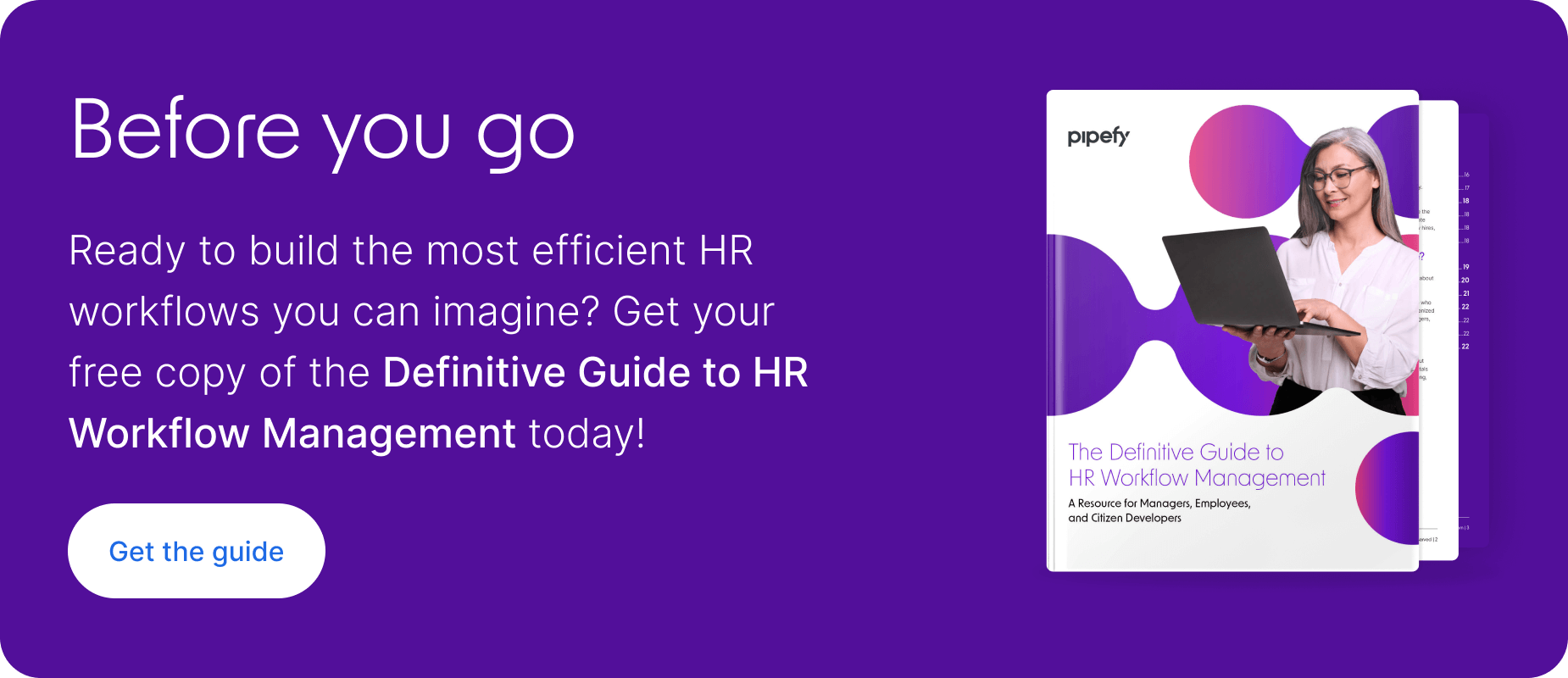
The importance of employee onboarding
The first day at a new job can be a daunting experience for a new employee, as well as the co-workers responsible for welcoming and integrating the newcomer. However, this pressure can be alleviated with a structured and well-defined employee onboarding process and an accompanying new hire checklist.
The employee onboarding process ensures a new hire acquires the information, knowledge, tools, and resources they need to integrate successfully into an organization. Onboarding can take place over the course of a few weeks or months and can even last up to a year and is fulfilled in a planned sequence of onboarding stages.
Onboarding new employees effectively are critical for increasing long-term engagement, retention, and productivity, so establishing a defined process for guiding all team members through this phase of the employee journey is paramount.
Field Guide to HR Workflow ManagementDownload guide
How to design an onboarding process
Employee onboarding isn’t a one-time event; it’s an ongoing process. While an employee’s first day is important, an effective onboarding program should start right after a job offer is accepted and well into their first year at a company, depending on the complexity of the position.
A thought-out and well-structured employee onboarding program is also about more than implementing administrative policies. It should immerse individuals into the company culture.
To help you design an efficient and structured onboarding process, here are some strategic questions to consider:
- What are the overall objectives?
- Which stakeholders should be involved?
- What information and materials do employees need?
- How long should the program last?
- What are the next steps after the program ends?
- Which parts of the onboarding process can be automated?
In addition to asking these questions, consider soliciting employee feedback to identify improvements and create an onboarding program that aligns with the organization’s broader talent management strategy and supports its long-term goals and objectives.
Check out the complete guide to employee onboarding to learn more about the process.
What is an employee onboarding checklist?
An employee onboarding checklist is used to standardize and organize the steps involved in welcoming and guiding new hires through their first days, weeks, and months at a company. In addition to helping organize the onboarding process, this checklist also helps align hiring managers on what’s expected of them throughout this process and what steps they can take to support new hires.
With an onboarding checklist that prioritizes compliance, clarification, culture, and connection, you can create better, more positive experiences for new employees, teams, and HR managers alike. that takes advantage of automation, assimilating new hires can be a positive experience for new employees and human resources managers alike.
Why is a new hire checklist critical for success?
New employees need specific information about their day-to-day role, including performance expectations and the breadth of resources at their disposal. They also need to understand the culture of the organization and the leadership structure.
In addition to welcoming new employees, the onboarding process is also a company’s opportunity to answer any questions and foster a sense of connection among other employees. The latter is especially important for companies with remote or hybrid employees.
A new hire checklist is critical for success because it ensures that every stage of the onboarding process is completed and puts the four C’s of onboarding into action: compliance, clarification, culture, and connection. Here’s how:
- Compliance. Have employees signed important documents required for their role or employment? Have they taken any necessary training?
- Clarification. Are all employee questions answered? Do they know what’s expected of them throughout the onboarding process? Is their role defined? Do they know who and where to report to on their first day?
- Culture. Have company values and culture been communicated? Has the company structure/directory been shared?
- Connection. Do employees feel welcome? Have they been introduced to their team or collaborators? Were welcome emails shared?
An effective employee onboarding process benefits both the company and the employee. At the same time, a poor onboarding experience can have a lasting negative impact. For example, if a new employee doesn’t fully understand expectations and responsibilities, they might not complete assignments as required. This could easily result in a loss of confidence among co-workers and managers and limit career advancement opportunities for years to come.
Importance for the company
A new hire checklist ensures that every step in the onboarding process is completed on time and according to the defined process. The faster a new employee becomes proficient at their job, the better the business is going to perform.
Successful onboarding supports increased employee engagement and can improve employee retention by 82%. Investing in new employees and speedy integration also drive higher productivity, leading to stronger business results and long-term value.
Importance for employees
With a comprehensive onboarding program and new hire checklist to accompany it, employees are set up for success quickly with a clear idea of role expectations, company policies, culture, and core values.
With their new hire journey paved and outlined, questions answered, and training assigned, employees can feel reassured about their decision to join (and remain at) your company.
New hire checklist guide and examples
A successful onboarding process doesn’t stop evolving once it’s been built. It’s also not just magically implemented. With the help of a new hire checklist, managers and HR teams can provide new employees with the best onboarding experience, improve employee engagement, and reduce turnover.
Below is a complete employee onboarding checklist that you can implement into your onboarding process or use as inspiration for your own customized checklist.
Pre-onboarding
The lead-up to the first day is also crucial for recruits. Preparing for an employee’s first day on the job is just as important as the first day itself, and creating an inviting environment for the new employee goes a long way.
Start to build buy-in among other team members early on. Be sure to clarify roles and responsibilities, and begin to share excitement for the team’s new hire. You can use this time to familiarize new hires with the organization and build anticipation by sharing an agenda detailing what they can expect for their first day and week.
Pre-onboarding checklist
- Establish a start date and work model
- Share a job offer with compensation and a start date outlined
- Negotiate compensation and finalize pay and benefits package (if applicable)
- Receive a signed job offer
- Alert the hiring manager of the new hire’s decision and official start date
- Send a welcome email to new hire (include any relevant documents, such as a copy of the signed contract)
- Prepare new-hire paperwork (job contract, tax forms, NDAs, benefits, employee handbook)
- Work with IT and new hire to order equipment (computer, keyboard, mouse, phone, tablet)v
- Work with IT to set up accounts and logins (email, wifi, messaging, and any job-specific technology or software)
- Request facility security clearance (if applicable)
- Set up their workspace (if remote, work with the new hire to set up their remote workspace)
- Share welcome kit (if applicable)
- Send the new hire an agenda detailing a breakdown of their first day, including start time and who they should report to
- Send the new hire a welcome questionnaire to help introduce them to the company and team
First day
The first day of a new job sets the stage for all that follows. A warm welcome paired with a well-coordinated first day can greatly reduce your new hire’s anxiety. Providing a great onboarding experience will set up the new employee for success and create a positive, lasting first impression.
First-day checklist
- Assign a buddy to guide and be the main point of contact for the new hire on their first day
- New hire orientation (share org structure chart, company directory, company values, and culture)
- Introduce the new hire to the company
- Perform facility tour (if applicable)
- Provide clearance or security badges or cards (if applicable)
- Set up 1:1 for the manager and new hire
- Set up a time with HR to review and fill out paperwork (benefits, insurance, stock options, payroll)
- Work with IT to finalize equipment setup
First week
A workday is only eight hours long, so it’s unlikely that you’ll get through everything that needs to be done or discussed in just one day. So while the first day is focused on orientation and welcoming new hires, the first week is focused on taking care of everything else.
First-week checklist
- Introduce the new hire to the team
- Plan team lunch (optional)
- Finalize employee paperwork
- Assign training (if applicable)
- Review technology policies
- Review employee handbook
- Finalize new-hire orientation
- Check in with the new hire to assess how they feel following their first week
First month
Nearly 33% of new hires look for a new job within their first six months on the job. This is a direct result of improper or insufficient onboarding. Many organizations make the mistake of ending the onboarding process after a week or even a day or two, which is not sufficient to engage new employees and set them up for long-term success.
Employees will start learning new skills and processes right away, but it takes at least a few months of work to become proficient. During the first month, companies should focus on anchoring learning through on-the-job experience and training for several months.
Extending the onboarding program beyond the first day will ensure newcomers are completing their training, asking the right questions, and becoming independent, productive employees. Extending onboarding will also help build social connections within the company.
First-month checklist
- Take care of outstanding paperwork
- Create manager and employee 1:1 meeting cadence
- Introduce new hire to the company’s performance evaluation program
- Check in with new hire to assess how they feel following their first month
- Ask employees for feedback on their onboarding experience and answer any remaining questions or concerns
- Celebrate milestone
- Schedule additional check-in plans to assess performance and gather feedback at 60 and 90 days
First year
While there needs to be an end date to the onboarding process, it’s important to continue the onboarding process throughout the first year of employment. This demonstrates a commitment from both the organization and the manager. Research shows that onboarding programs that last at least one year increase new hire retention rates by as much as 25% compared to shorter onboarding programs.
At the one-year mark, the focus should shift from training and onboarding to continuous development and career management. At this point, the onboarding process can be considered completed as the focus shifts to employee retention and engagement.
First-year checklist
- Celebrate milestone by sending a congratulatory email and gift (optional)
- Ask for feedback to gauge employee engagement and experience
- Conduct a one-year performance review
- Address gaps in skills and provide training to build confidence and fill gaps
- Discuss career goals, interests, and internal job opportunities
Benefits of an automated onboarding process
In addition to establishing a comprehensive onboarding process and checklist, consider using a process management platform to automate your onboarding process and standardize the completion of your new hire checklist.
These tools make implementing a robust and responsive onboarding program hassle-free, so HR teams and managers can use the platform to streamline and optimize the onboarding process in a variety of ways. Here are just a few examples of how:
Improves communication, collaboration, and visibility
Eliminate miscommunication and keep all stakeholders updated through automatic emails and notifications. With automated notifications and emails, never lose track of a request, status update, or alert again. It’s also easier to keep processes and collaboration running smoothly, without interruption or delays.
Standardizes new employee journeys
The pre-onboarding period is the most vulnerable to missed or delayed steps. By automating steps like issuing/collecting signed new-hire documents, issuing equipment, or providing important details on what to expect for their first day, standardizing steps ensure that all new hires start on the right path — no matter where they are in their onboarding journey.
Offer a consistent experience to new employees and engage them in all phases of the onboarding process. By making this process more consistent, HR teams and hiring managers have better insight into how to incorporate ongoing feedback and evaluation from participants.
Eliminates repetitive tasks
Repetitive work is a top barrier to productivity. In fact, 76% of employees report spending up to three hours each day on data entry alone. And when it comes to the root of burnout, 30% report that repetitive work is the cause. Keep both to a minimum with automation software to reduce time-consuming and repetitive tasks that lead to employee burnout.
By integrating your automation software with existing systems and apps, seamlessly create a more streamlined and accurate onboarding process experience for HR teams and managers. Tasks like updating information, moving new hires down the onboarding process, sharing updates, or assigning approvers can be easily automated so more time is spent with people, not paperwork.
Increases data reliability and reporting
One of the key benefits of business process automation (BPA) is its ability to track and report on process performance and any other related process metrics. With a BPA solution, identify all the onboarding topics and activities to be covered and track them to ensure completion.
Creates more time for HR teams and managers to invest in employees
The customization, automation, and integration features offered by process management software make it easy to design an onboarding process that is unique, supports organizational goals and objectives and provides a seamless and collaborative experience for all teams, departments, or systems involved.
With less time spent managing processes and time-consuming tasks, HR teams and managers are able to reinvest that time into connecting with new hires and creating better employee experiences.
Improve your employee onboarding with Pipefy
Successful employee onboarding is essential to maintaining an engaged and productive workforce. Pipefy’s automation software streamlines the process and ensures consistency across the organization and enhances the employee onboarding process for employees, HR teams, and managers.
Using an automation and management platform like Pipefy is a great way to ensure crucial information, tasks, and activities aren’t overlooked so that employees are supported with the best employee experience. Learn how to use Pipefy’s employee onboarding template to thoughtfully welcome new hires with this informative employee onboarding template tutorial.






